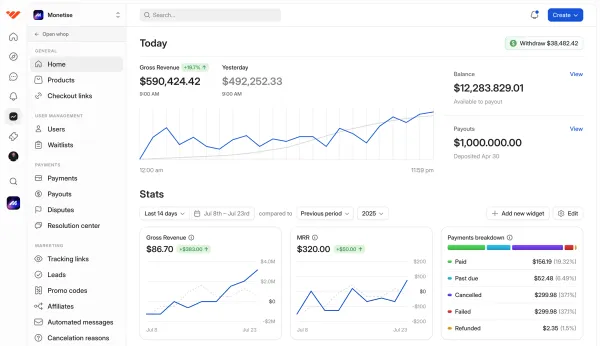Stripe is a payment processing platform that lets businesses accept online payments, manage subscriptions, and handle transactions securely. Learn how it works, key features, and whether it’s the right fit for your business
Stripe is a global payment service provider that lets businesses accept cards, wallets, and bank payments online and in person.
It handles everything from one-time purchases to recurring billing, without you needing to build a payment system from scratch.
In this guide, we'll break down how Stripe works, its key features, pricing, and whether it's the right fit for your business.
We'll also compare it to other payment processors like PayPal, Square, and Whop Payments so you can pick the smartest option for your setup.
What is Stripe?
Stripe combines payment gateway and processor functions into one platform. It's PCI Level 1 certified (the highest security standard), trusted by companies like Shopify, Lyft, and Amazon, and known for its developer-friendly APIs that let you build custom checkout flows and subscriptions.
Unlike traditional merchant accounts that require lengthy bank approvals, Stripe uses aggregated accounts to simplify onboarding—most businesses can start accepting payments within minutes.
Its product suite includes:
- Billing for subscriptions and recurring revenue
- Connect for marketplace and platform payouts
- Issuing for creating virtual and physical cards
- Atlas for company incorporation
- Terminal for in-person sales
Merchants remain the Merchant of Record unless using Stripe Managed Payments, meaning you're responsible for disputes, chargebacks, and tax compliance.
Stripe's real strength is its developer-friendly APIs, offering flexible, customizable payment flows that can be tailored to your exact business needs.
How does Stripe work?

Stripe simplifies the flow of money between your customers and your business.
When a customer checks out, Stripe securely transmits their payment details, validates the transaction with their bank, and ensures funds reach your account—usually within 2 business days (timelines vary by country).
Here’s the process broken down step by step:
- Customer enters payment details: This could be a card, digital wallet, bank debit, or other supported method.
- Stripe encrypts and transmits the data: Information is sent through Stripe’s PCI Level 1 compliant gateway over HTTPS.
- Acquiring bank and networks: Stripe’s acquiring partner submits the payment to the relevant card network (Visa, Mastercard, AmEx, etc.).
- Issuer authorization: The customer’s bank (issuer) approves or declines the transaction based on available funds and fraud checks.
- Response back through Stripe: The approval or decline is sent back to Stripe, which instantly shows the result at checkout.
- Funds settlement: If approved, the transaction clears and funds are deposited into your Stripe balance. From there, Stripe transfers payouts to your bank account, typically in 2 days (faster in some countries, slower for high-risk industries or first payouts).
This entire authorization process happens in seconds, giving your customer a smooth checkout experience. Stripe then handles settlement and payout behind the scenes.
For recurring payments, invoicing, and subscriptions, Stripe can also securely store customer details using its customer object system—removing the burden of PCI compliance from the merchant.
Is Stripe safe for businesses and customers?
Stripe is widely regarded as a safe and secure payment platform. It’s certified as a PCI DSS Level 1 provider — the highest level available — and goes through independent audits, security scans, and compliance checks each year.
From a business perspective:
- PCI compliance is handled, so you don’t need to store sensitive card data yourself.
- Fraud tools like Radar and 3D Secure help reduce risk, though they can require extra setup and add cost.
- Stripe offers reporting and dispute management tools, but chargebacks still fall on you to resolve.
From a customer perspective:
- Transactions are encrypted, tokenized, and run through HTTPS/TLS.
- Card data never touches your servers, which reduces exposure.
- Stripe’s global infrastructure meets compliance standards like GDPR and PSD2, though regional requirements can sometimes add friction at checkout.
Stripe delivers strong, enterprise-level security. The trade-off is that many of the protections come with complexity, extra fees, or responsibilities that still sit with the business owner.
What are the Stripe fees and payment methods?
Stripe charges transaction fees based on the payment method, location, and whether the payment is domestic or international.
As of 2025, the standard fee structure in the U.S. is:
- Online payments (card-not-present): 3.4% + 30¢ per successful transaction
- In-person payments: 2.9% + 30¢ per transaction
For international payments:
- An additional 1.5% fee applies for international cards.
- If currency conversion is required, another 1% fee applies.
These are standard rates—custom pricing may be available for high-volume businesses.
Is Stripe the best option for your business?
Stripe is one of the most widely used payment platforms worldwide. It’s trusted by businesses from startups to global brands like Shopify, Lyft, Amazon, and Google.
But Stripe isn’t a one-size-fits-all solution — it works best for certain types of businesses:
1. Ecommerce platforms
Stripe integrates directly with major ecommerce builders like Shopify, WooCommerce, BigCommerce, and Squarespace. Setup can be quick if you’re already using one of these platforms.
That said, fees can stack up, and flexibility may be limited if you’re locked into their ecosystem.
2. Developer-heavy businesses
Stripe is known for its developer-friendly APIs. If you have technical support, you can build custom checkout flows, subscriptions, and marketplace payouts. For non-technical teams, Stripe does offer no-code tools like Payment Links, but deeper customization often requires coding resources.
3. International sellers
Stripe supports 135+ currencies and localized payment methods such as iDEAL (Netherlands), Bancontact (Belgium), and SEPA Direct Debit (EU). This makes it strong for global commerce.
The trade-off: Stripe isn’t available in every region, and onboarding can be stricter for certain countries.
4. Businesses with strict security needs
Stripe is PCI DSS Level 1 certified and includes fraud prevention (Radar), 3D Secure, and compliance with laws like GDPR and PSD2.
Security is strong — but you’re still the Merchant of Record, meaning you carry the weight of disputes, taxes, and chargebacks.
Prohibited and restricted industries on Stripe
Stripe clearly outlines a range of business types it does not support, categorizing them as either prohibited (always disallowed) or restricted (which require additional due diligence or preapproval).
The list below reflects the most current version of Stripe's policy and is not exhaustive – there may be additional restrictions depending on jurisdiction or specific service use.
Stripe reviews all applications and may request further documentation if your business falls into these categories .
- Illegal products or services (e.g. narcotics, equipment for drug production, unlawful activities)
- Adult content and services (e.g. pornography, escorts, strip clubs, adult live chat, adult-themed dating)
- Debt relief companies, including debt settlement and debt consolidation
- Certain financial services like payday lenders, debt collection agencies, peer-to-peer money transmission, crowdfunding, bearer shares, shell banks, money orders, traveler's checks
- Gambling and betting activities (e.g. casinos, sweepstakes, fantasy leagues, lotteries, skill contests with prizes, sports betting)
- Travel-related services such as airlines, cruises, timeshares, travel reservations and clubs
- Identity and government services misuse (e.g. unauthorized legal advisory, identity theft protection, misleading government offerings)
- Intellectual property violations (e.g. counterfeit goods, unauthorized distribution of copyrighted media, violation of trademarks or trade secrets)
- Legal services not limited to fee-only models like bankruptcy lawyers or bail bonds operations collecting funds beyond lawful fees
- Marijuana and related products (e.g. cannabis, dispensary services, cultivation paraphernalia, high-THC or majority-CBD products, cultivation courses)
- Nutraceuticals or pseudo-pharmaceuticals making harmful or unverified claims
- Non‑fiat currency operations including cryptocurrency mining, staking, ICOs, NFTs (secondary sales)
- Unfair or deceptive business practices including MLMs, pyramid schemes, "get rich quick" schemes, deceptive testimonials, unrealistic rewards, telemarketing scams
- Weapons, firearms, and dangerous materials (e.g. guns, explosives, ammunition, fireworks, pepper spray, swords)
- Content creation platforms that distribute third-party content—those must have strong content moderation and require preapproval
Also, Stripe prohibits servicing high-risk jurisdictions and individuals, such as sanctioned countries (e.g. Cuba, Iran, North Korea, Syria, Crimea, Donetsk, Luhansk) or persons flagged by international sanction.
Advantages and disadvantages of using Stripe as your PSP
Stripe is a popular and well-established PSP, but like any platform, it has strengths and weaknesses. Here’s the breakdown:
Stripe pros
- Strong security: PCI DSS Level 1 certified with built-in fraud prevention tools.
- Global reach: Supports 135+ currencies across dozens of countries.
- Flexible payment options: Accepts cards, wallets, and local payment methods.
- Developer-friendly: Powerful APIs for custom checkout, subscriptions, and marketplace setups.
Stripe cons
- Costs add up: Extra features and international transactions can push fees higher than competitors.
- Developer dependency: Non-technical businesses may struggle to unlock Stripe’s full potential.
- Physical retail isn’t a fit: Stripe Terminal exists, but it’s not as strong as POS-focused solutions.
- Industry restrictions: Stripe does not work with certain businesses. This includes adult content, gambling, payday lending, debt services, marijuana, nutraceuticals with unverified claims, firearms, and crypto operations like ICOs and mining. Stripe also blocks high-risk regions (e.g. Cuba, Iran, North Korea) and any sanctioned individuals or entities.
Stripe is powerful, secure, and global — but it’s not designed for every business model. If you fall into a restricted category or don’t have developer resources, you may find the platform limiting.
The best alternatives to Stripe for payment processing
Stripe won’t be the right fit for every business. If you’re selling in a restricted industry (like sports betting or cannabis) or you want to accept crypto payments, Stripe simply won’t work.
Here are some other PSPs that might suit your needs better.
Whop Payments
Whop payments offers flexibility beyond traditional PSPs like Stripe. It supports built-in crypto payments, allowing merchants to accept various cryptocurrencies via an ETH gateway or similar setup.
Additionally, Whop acts as the Merchant of Record (MoR) and automatically handles currency conversion and payouts to your preferred local currency. For geographies where Stripe isn't available, Whop offers alternative payout methods like PayPal, bank transfers, and crypto.
PayPal
PayPal remains one of the most accessible payment platforms globally. It is available in over 200 countries and regions, supporting 25 currencies, making it broader in geographic coverage than Stripe's operational footprint.
PayPal stands out for its straightforward, non-technical setup, ideal for small businesses and solopreneurs looking to start receiving payments quickly.
Square
If your business operates offline or in physical locations, Square is a compelling choice. Square dominates the in-person payments landscape in the U.S., providing a range of hardware solutions like card readers, terminals, registers, and comprehensive POS software.
While it supports online payments too, its strength lies in seamless, plug-and-play in-person commerce supported by intuitive dashboard tooling and inventory functions.
Use Whop Payments as your PSP and MoR
Stripe works for some, but if you want purchases to actually drive growth?
You need Whop Payments.
We've developed a global, adaptive system that reaches customers in 241+ territories, supports local bank transfers and crypto (bitcoin + stablecoins), and pays you out fast.
With built-in KYC, you can start transacting in minutes, and transparent, flat fees keep costs predictable.
You can embed checkout on your site, share standalone links, or run your whole business on Whop – it's the same seamless experience either way.
“We're routing every single payment to a number of different service providers to max out authorization rate via local rails, bitcoin, and stablecoin.”
- Whop Co-Founder, Steven Schwartz
Ready to turn payments into a growth engine?
Let’s make every payment count.
Stripe FAQs
Is Stripe secure?
Yes. Stripe is PCI DSS Level 1 certified, which is the highest standard in the industry. It uses tokenization, TLS encryption, and fraud tools like Radar. That said, merchants are still on the hook for disputes, chargebacks, and compliance.
What businesses can’t use Stripe?
Stripe has a long list of prohibited and restricted industries. These include adult content, gambling, payday lending, debt collection, marijuana, firearms, nutraceuticals, and many crypto-related services (like ICOs and mining). If you’re in one of these spaces, you’ll need an alternative PSP.
How fast are Stripe payouts?
Stripe typically pays out in 2–7 business days depending on your country. In some regions, payouts can take even longer for new accounts.
What are Stripe’s biggest downsides?
Stripe’s main friction points are: fees that add up (especially for international transactions), reliance on developer resources for advanced customization, and its limited support for certain industries and regions.
What makes Whop Payments different from Stripe?
Whop Payments is built for modern entrepreneurs. Whop powers payouts in 241+ territories, supports local bank transfers and crypto (Bitcoin and stablecoins), and routes every transaction through the provider most likely to approve it. This reduces declines, increases revenue, and gets sellers paid faster.
Does Whop Payments support crypto?
Yes. Whop Payments supports payouts in Bitcoin and stablecoins in addition to local banking rails. Sellers can also set up an ETH gateway to accept crypto directly from customers.
How long does it take to get started with Whop Payments?
With built-in KYC, most sellers can start transacting within minutes. There’s no lengthy bank onboarding process or complex account setup.
What’s the pricing for Whop Payments?
Whop Payments offers flat, transparent fees with no hidden add-ons for features like fraud protection or routing. This makes it easier to forecast costs compared to traditional PSPs.
Is Whop Payments available worldwide?
Yes. Whop now powers payouts in over 241 territories, making it one of the most globally accessible payment solutions available.




![How to sell digital products without a website - ultimate guide [2026]](/blog/content/images/size/w1000/2024/02/How-to-Sell-Digital-Products.webp)









![PayPal for business: What it is, how it works, fees, and top alternatives [2026]](/blog/content/images/size/w1000/2025/11/PayPal.jpeg)